
Photo from wikipedia
In this research, we compared the phenotypical characters, total anthocyanins content, total phenols content, and antioxidant activity of red-fleshed apple cultivars ‘XJ4’, ‘QN-5’, ‘DH’ and ‘HX1’ at three fruit developmental… Click to show full abstract
In this research, we compared the phenotypical characters, total anthocyanins content, total phenols content, and antioxidant activity of red-fleshed apple cultivars ‘XJ4’, ‘QN-5’, ‘DH’ and ‘HX1’ at three fruit developmental stages. A further flavonoids metabolites study was conducted in ‘XJ4’ and ‘DH’. We found broader variation of total anthocyanins content in the peel of the four cultivars, which might result in larger differences of free radicals scavenging rate. The most significant difference in fruit phenotype, anthocyanins content, and DPPH scavenging rate was observed between ‘XJ4’ and ‘DH’ at mature stage. Therefore, the flavonoids metabolites of ‘XJ4’ and ‘DH’ at mature stage were compared to unveil the details of anthocyanins compounds. The unique compounds pelargonidin 3-O-β-d-glucoside and cyanidin-3-O-malonylhexoside were detected only in peel and flesh of ‘XJ4’ but not in ‘DH’, which might contribute to the purple peel and dark-red flesh color of ‘XJ4’. Significantly decreased upstream metabolites in the early biosynthetic genes regulated domain were found only in ‘XJ4’ peel but not in the flesh. This might explain why the anthocyanins content in ‘XJ4’ peel was decreased largely at the mature stage. Taken together, our findings will give some insight into the metabolites study in flavonoid biosynthetic pathway of red-fleshed apple.
Journal Title: Molecules
Year Published: 2020
Link to full text (if available)
Share on Social Media: Sign Up to like & get
recommendations!